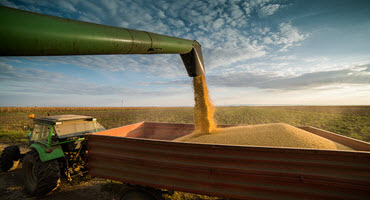South Dakota leads the country in that category
By Diego Flammini
News Reporter
Farms.com
The US winter wheat crop has surpassed the halfway point for emergence, according to the United States Department of Agriculture’s (USDA) latest Weekly Weather and Crop Bulletin.
52 percent of the total U.S. winter wheat crop has emerged as of Oct. 22. That number is up 15 percent from last week, but still down 6 percent from last year’s figures at this time.
At the state level, 80 percent of the winter wheat crop in South Dakota has emerged. That number is up from 67 percent last week and represents the highest percentage of the 18 states documented.
And with only 1 percent of its winter wheat crop up, California has the lowest recorded winter wheat emergence. That number is down from 3 percent at this time last year.
Corn
Corn harvest completion jumped by 10 percent in one week.
Farmers have harvested 38 percent of the total U.S. corn crop, up from 28 percent last week, according to the USDA. But that number is still behind the 59 percent harvest completion measured at this time last year.
Corn producers in Tennessee and North Carolina have combined 95 percent of their corn crop, which are the highest percentages in the country.

And corn farmers in Minnesota have only completed 14 percent of their harvest. That number is the lowest in the U.S. but represented a 50 percent increase from last week, according to the USDA.
The USDA ranked 50 percent of the total corn crop as good.
Soybeans
Soybean harvest in the U.S. increased by 21 percent since last week.
American soybean farmers have harvested 70 percent of their soybeans as of Oct. 22, the USDA reports. That number represents a 21 percent increase from last week’s figures.
At the state level, soybean producers in Louisiana have combined 98 percent of their crop. That number is up from 95 percent last week and is the highest percentage among the 18 states documented.

Farmers in North Carolina have completed 34 percent of their soybean harvest, according to the USDA. That number is the lowest in the U.S., but represents an 8 percent increase from last week.
Suitable fieldwork days
The states with the most suitable fieldwork days for the week ending Oct. 22 were:
California, Arizona, New Hampshire, Vermont, Massachusetts, Connecticut and Maryland – 7 days
And the states with the fewest suitable fieldwork days were:
Washington – 4.3 days
Missouri – 4.9 days
Oregon, Iowa, Wisconsin and Rhode Island – 5 days
Weekly precipitation levels
State | Precipitation (inches) | Weather Station |
Illinois | 0.43 | Peoria |
Indiana | 0.38 | South Bend |
Iowa | 0.96 | Des Moines |
Kentucky | 0.37 | Jackson |
Michigan | 0.72 | Alpena |
Missouri | 2.64 | Kansas City |
New York | 0.58 | Binghamton |
Pennsylvania | 0.42 | Erie |
Tennessee | 0.59 | Knoxville |
The next Weekly Weather and Crop Bulletin will be released on Tues., Oct. 31.